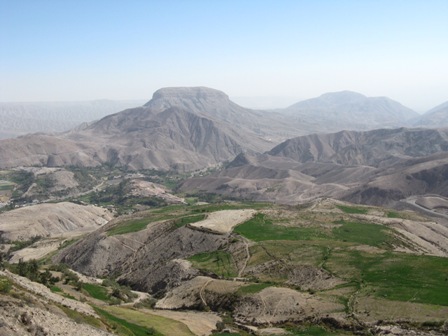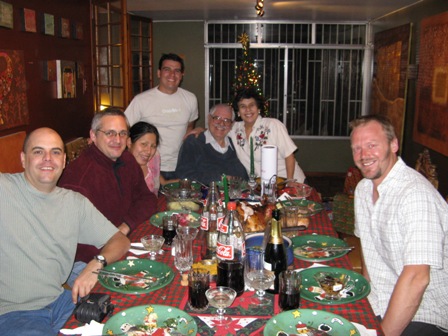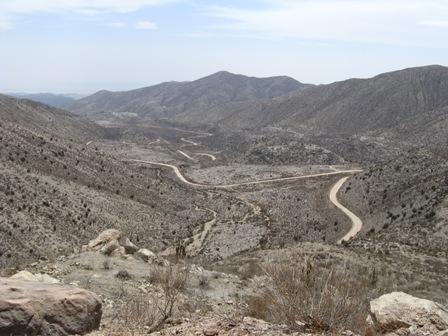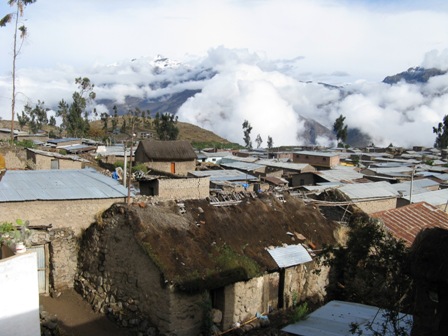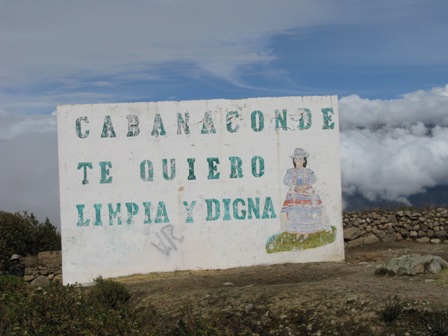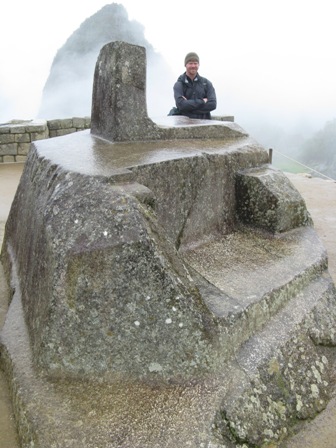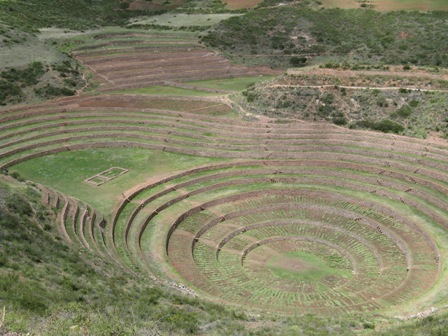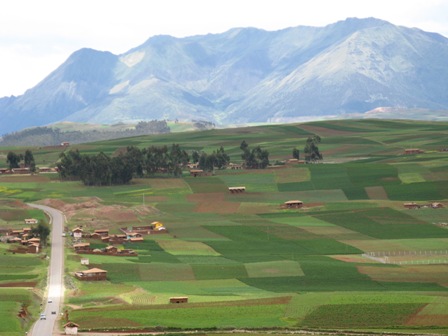Inca Kola
Peru's version of IrnBru
Looks like anti-freeze, tastes like IrnBru, Peru's national drink was so popular that Coca Cola couldn't beat it - so they bought it. As we were shortly to find out, it is sold everywhere....
We're getting there slowly (wherever 'there' is)

Loo at the Peruvian border
One of the first things we noticed about Peru was the desire of car drivers to drive on our side of the road. If they happened to be doing this, instead of getting out of the way, they'd flash their lights madly at you, as if to say, "Move!" It felt like we were back in Asia so it didn't take us long to get used to it. And they love 'horning', to use a Malaysian expression.
A very looooooong road on the way to Arequipa
The next thing we noticed was the amount of 'Chifas' - Chinese restaurants - excellent!
Apart from that first impressions of Peru were positive; friendly people, loads of amazing scenery and some great roads to explore.
Not forgetting new beer to try!
Twisty turns through the desert on the Desaguardero - Moquegua road
View of table top mountain near Torata on the way to Arequipa
Wildlife includes flamingoes, vicunas and of course, llamas, which are farmed extensively throughout Peru's highlands.
Long roads and llamas
Later, Hame found one to play with.
Hame and his new friend. Should I worry?
We dressed Bertha up a bit to get in the Christmas spirit.
Bertha and Santa
Frog gets festive
Upon arrival at Bob and Angie's in Arequipa, we met Angie's lovely and warm family, and were invited to Christmas Eve dinner.
Christmas dinner with Bob and Angie and Angie's wonderful and kind family
Peruvians celebrate Christmas the night before, on Christmas Eve, eating a sumptious dinner and opening presents late in the evening. Every member of Angie's family cooks, so there were amazing smells coming from every room, and a succession of cooks coming up to Bob and Angie's apartment to check on the progress of the pork.
After dinner there was mass present unwrapping - in which we were not forgotten!
Xmas pressies
At midnight we went up to the roof to watch the fireworks. Though illegal to buy them, it seemed that every house in Arequipa had a display and for almost an hour, all over the city, they were let off - it sounded a little like being in a war zone, but was very beautiful.
Paolo, Angie's brother, invited us up to his apartment on the third floor (the house was like a tardis) where we drank pisco and admired his ancient weapons collection. I'm not a huge fan of guns, but these were really interesting, especially one which had belonged to Will Child, a pirate sent by Francis Drake to sack Lima (I think that was the story, anyway) and was over 400 years old.
"Right, Rudolf!"
Hame was interested in an 1892 Winchester .40-40 and asked if it still worked. "Of course, want to see?" asked Paolo, picking up a couple of bullets from the table and heading off to the balcony. We followed, just in time to see him lean over the balcony, take aim at the garden and fire! Apparently this is fairly normal behaviour in Peru and the police take no notice. As well as being an gun collector, Paolo is also a well-known Peruvian artist (Paolo Cordano) who sells his work all over the world. Angie's other brother builds custom cars - they are an interesting family!
Hame and I with Bob and Angie
Arequipa is surrounded by mountains and volcanoes
Arequipa by night, Hame Bob and Angie near the main plaza.
We spent a week with Angie and Bob, watching loads of movies - something we rarely get to do - and exploring Arequipa. My favourite place was the Santa Catalina Convent in the town centre, founded in 1579 and closed to the world until 1978. It was fascinating to walk around this 'city within a city'.
Santa Catalina Convent
Hame and I decided to head to Colca Canyon for New Year, so we said our farewells and were escorted out of town by our fab hosts.
Angie and Bob seeing us off
The road to Cabanaconde
We took the alternative route (as ever) and turned off at Tambillo to head for the hills. A long ride on some interesting roads took us up through the clouds to Cabanaconde, where we arrived just as the heavens opened. We splashed out (scuse the pun) on a plush (for us) hotel and managed to get Bertha up four steep stairs into the lobby.
Bertha in another lobby
It was cold so that Hame and I parked ourselves by the fire and had a warming whisky. After our long ride we started to yawn, but were determined to wait for the party. The only problem was, with only two other (very quiet) guests in the hotel there wasn't much happening. It got to about 11pm and Cabanaconde lost its power. We sat by candlelight for a bit and then gave up, getting to bed before midnight on Hogmanay - has to be a first!
We woke to amazing views of the village and the edge of the canyon. We went for a walk to the viewpoint where you can stand on the edge of a steep drop off down into the canyon. It was quite incredible.
Great views for most of the day....
... and then in the afternoons, the town was swallowed by a cloud.
Every day at about 3pm a big cloud came and settled on Cabanconde, drenching the place and dropping visability to about ten metres. With this in mind we got a horribly early start the next day to walk down into the canyon.
Tip: if the views are at the top, and you are at the top, there's absolutely no need to walk to the bottom.
Down into the canyon....
Yes, I moaned. Lots. But I did resist the temptation of taking a ride, even though three men walked past with mules, offering me one each time. Hame was his usual goat-like self; I struggled. Down wasn't so bad except that it was pretty steep, but up was a killer, taking a full four hours to stumble upwards, with NO flat bits. "Never again," I said in a growly voice.
Getting Bertha out of the hotel in Cabanaconde, on our way again
Hambo!!!
Cabanaconde sign
Looking for condors
Hame in the clouds
It was the wrong time of the year to see the condors at the Mirador Cruz del Condor, but we took in a view great views on the way to Chivay, as well as an 'interesting' tunnel.
Water filled tunnel
Because of all the rain, we'd decided to be sensible (bah) and take the asphalt road towards Juliaca. It was way colder than we expected with a hailstorm to boot and we had to stop to pile on more layers in the village where we thought there was a hotel. As there wasn't one, we rode on two more hours thorugh interesting valleys to Juliaca where we found a hostel with friendly owners. The first thing they did was measure the bike, saying they were building a new door and wanted to make sure they could still fit bikes in. On the way there we saw a bike even more heavily loaded than ours...
And we thought WE were overloaded...!
Woohoo!!!! 100,000km
Juliaca was described as 'brash' by our guidebook and we saw no reason to disagree, though it wasn't unpleasant. After another day's ride, we arrived in Cusco and checked into Casa Grande - a hostel I'd seen a picture of in Chris Scott's Adventure Motorcycling Handbook while planning the trip - at the time I thought, "It looks sooo South American" - funny to be here at last.
Casa Grande
A random bit of Inca wall
Cusco's flag next to Peru's flag
We spent a few days exploring Cusco which is full of bits of Inca wall all over the place, street sellers who drive you nuts after a while, great eateries and Spanish colonial buildings. I liked it. There are some ruins in the hills above Cusco, Saqsaywaman, which we spent a day exploring on Hame's birthday.
Inca walls
The walls amazed us both - the stonework is just incredible, especially as the Inas used only stone tools. Many stones from the walls were taken by the Spanish invaders, and some collapsed in earthquakes so what is left is probably less than 20% of the original ruins- it is still amazing to see.
The Inca empire reached a peak after they invaded the territories of several other tribes, but it only stayed at this peak for about a century, before the Spanish came and conquered.
Hame under the bar
We caught the famous 'Norton Rat's Tavern' on its last night before Jeff moved around the corner. This was good as Hame had to 'help drink up the beer' (I'll be back in an hour, Em. Honest!). The next day we went back to help move stuff and again, helped empty the barrel of Old Speckled Hen - difficult job. The new Rat's will open in February.
Oh no, you mean there's MORE drinking up to be done?
We spent a few eveings with Jeff and Yahita and found them to be great company.
In the Irish bar with Richard, Jeff and Yahita
Cusco is gateway to Peru's (and maybe South America's) most famous site; certainly the most well-known. Machu Picchu was 'discovered' in 1911 by Harem Bingham, an American archaeologist. I use inverted commas because the locals already knew about the city but Bingham is credited with opening it up to the world (and 'borrowing' 45,000 artifacts from the site for 18 months which are still, to this day, in a museum at Yale University).
Meeting Brazilian Sergio in the Sacred Valley, on the way to Machu Picchu
We rode towards Machu Picchu through the Sacred Valley - a beautiful valley full of Inca ruins. On the way we hooked up with Jeff who runs balloon trips over the valley (unfortunately for us, we were a month too early as he's not doing business until February). Jeff's a friend of Val and Adam and it was good to meet him. He'd also acted as 'Marmite depot' for me after Val left me a jar (what a woman!). Despite Jeff's threats to use it as axle grease, he'd kept it for me.
My Marmite depot
On the way we stopped at Pisac and admired the Inca terracing - incredible land use.
Inca terracing at Pisac
We'd opted not to take the Inca trail to Machu Picchu for a variety of reasons and instead rode the bike to Ollaytaytambo where we found a cheap hostel to stash it in, spending a night there ourselves.
Street in Ollaytaytambo - people have been living here continuously since the thirteenth century
Ollaytaytambo itself had really breathtaking ruins to explore - the Incas were very clever at making the most of the steep hillsides, terracing the surrounding hills in the Sacred Valley to produce more than enough food for the neighbouring cities. Nobody went hungry in Inca times.
Granny in our hostel peeling spuds - cat helping itself
Ollaytaytambo had a good little museum about the Inca Empire and we learned all sorts, including how they built those massive walls.
Hame helping Inca builders
The walls unfinished - when finished the nodules were knocked off.
Guinea pigs have two roles in Peruvian life: as pets and as food. We've so far avoided having to eat it. In the mornings in Ollaytaytambo, we ate breakfast in the family kitchen and I was interested to notice this picture - hanging above the cooker...
Yum
Leaving Bertha in the safe hands of Fabio and his family, we caught the train to Aguas Calientes, or 'Machu Picchu town'. Aguas Calientes exists solely for the purpose of putting up tourists who visit the ruins, and therefore it's not a great town. It has thermal baths - hence the name - which smelt slightly of pee; we took a bath in the least smelly one.
Train running through town - literally
At three the next morning the alarm went off and we leapt enthusiastically out of bed (you know I'm lying) to be greeted by a dark and rainy morning.
Us up with the larks. Except the larks were still asleep.
We set off with a few other walkers for the one and a half hour trek up to the ruins. We arrived before it was officially open and stood waiting at the gates. At six o'clock sharp we were allowed in - it was pretty amazing being first there.
Machu Picchu
After all the pictures I've seen of Machu Picchu I was ready to be disappointed - rarely does the reality live up to the myth. This time, it did. We sat and watched the clouds part over the ruins and it was truly breathtaking. Because of the nasty weather we got to do this a few times; the clouds came and went for the whole day.
We were there!
As it was raining, there were fewer people there which was great, it wasn't busy at all. We spent all day there, almost twelve hours, and I loved every minute. It was absolutely fascinating and because of its breathtaking setting, perched between two hills, and high above everything around, it's one of the most incredible sites I've ever seen.
The Inca sun-dial - but where's the sun? (Still intact which is proof that the Spanish never found Machu Picchu)
Despite my 'never again' growls about hills, we hiked up Huayna Picchu, (the big pointy one you see behind the ruins in photos). It was a steep but reasonable climb and as the views are supposed to be incredible there's a lot of motivation.
Hame at the top - great views! Not.
Unfortunately the clouds only let us have a brief peek at the view but the ruins up the hill were worth walking up for. Goodness knows how they built them, because it is a very pointy hill and there were obviously a lot of people living up there, in buildings surrounded by steep, steep terracing.
Steep steps coming down Huayna Picchu
We slithered back down the hill and explored the rest of the ruins. The rain, as well as ensuring there were less people there, allowed us to see Inca water-engineering at work so we didn't mind too much. We did get absolutely soaked and back on the bus I met my rudest tourist yet (we've met a fair few of them) - a woman who told me to catch another bus instead of sitting next to her because I was so wet. At the same time the driver was telling me to sit down so I wasn't best pleased.
You can see some videos of the Inca sites we visited below:
Back in Nasty Calientes we ate and dried off before catching the train back to find our trusty steed. We rode back the next day via Moray, an old Inca farming site where people think the Incas experimented with different crops - on each level the temperature is different, therefore they could mimic different the temperatures found throughout the empire.
Moray
Modern farming
Maize is everywhere. In Inca times it was a scared crop and in modern times it's in just about everything. It's big, fat and tasty, and not at all like the wimpy yellow stuff we buy in the west.
Dried maize
In Cusco Hame and I moved back to Casa Grande and were lucky to get a room with a bit of Inca wall running through it.
The cathedral on the plaza
We stayed a bit longer to get some dentistry done for the first time since leaving; a well-recommended woman called Xiomara sorted us both out, for a fraction of the cost of the dentists in the UK. You'd actually be better off flying to Peru, staying in a hotel and having treatment than having stuff done in the UK - really! If you're interested let us know, we'll give you her name.
On the way to and from Cusco, as well as in it, we met lots of friendly Colombian bikers. All of them, without exception, invited us to stay in Colombia and have to be the friendliest bunch of people we've met yet.
Friendly Colombians at Casa Grande
We finally escaped Cusco after a good stay, and headed off towards the 'road of a thousand bends', towards Nazca, site of the famous Nazca lines and our next destination.
(Emma)
Us outside IncaBurger - no we didn't eat there!
Pic of the month:

You get more for your money in Peru!







